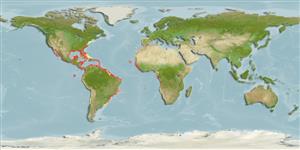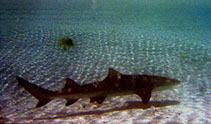Negaprion brevirostris (Poey, 1868)
Lemon shark
Add your observation in Fish Watcher
| Native range | All suitable habitat | Point map | Year 2050 |

|
| This map was computer-generated and has not yet been reviewed. |
| Negaprion brevirostris AquaMaps Data sources: GBIF OBIS |
Upload your photos and videos
Pictures | Videos | Google imageNegaprion brevirostris
Picture by Sampaio, C.L.S.
Pictures | Videos | Google imageNegaprion brevirostris
Picture by Sampaio, C.L.S.
United States (contiguous states) country information
Common names:
Lemon shark
Occurrence: native
Salinity: brackish
Abundance: | Ref:
Importance: | Ref:
Aquaculture: | Ref:
Regulations: | Ref:
Uses: no uses
Comments:
National Checklist:
Country Information: https://www.cia.gov/library/publications/resources/the-world-factbook/geos/us.html
National Fisheries Authority: http://www.nmfs.gov
Occurrences: Occurrences Point map
Main Ref: Compagno, L.J.V., 1984
National Database:
Occurrence: native
Salinity: brackish
Abundance: | Ref:
Importance: | Ref:
Aquaculture: | Ref:
Regulations: | Ref:
Uses: no uses
Comments:
National Checklist:
Country Information: https://www.cia.gov/library/publications/resources/the-world-factbook/geos/us.html
National Fisheries Authority: http://www.nmfs.gov
Occurrences: Occurrences Point map
Main Ref: Compagno, L.J.V., 1984
National Database:
Common names from other countries
Classification / Names Populärnamn | synonymer | Catalog of Fishes(Släkte, Arter) | ITIS | CoL | WoRMS | Cloffa
Elasmobranchii (hajar och rockor) (sharks and rays) > Carcharhiniformes (Ground sharks) > Carcharhinidae (Requiem sharks)
Etymology: Negaprion: negatus (L.), to deny; prion (Gr.), saw, referring to lack of saw-like serrations on teeth cusps (See ETYFish); brevirostris: brevis (L.), short; rostrum (L.), snout, referring to short, flat and broadly rounded snout (See ETYFish).
More on author: Poey.
Etymology: Negaprion: negatus (L.), to deny; prion (Gr.), saw, referring to lack of saw-like serrations on teeth cusps (See ETYFish); brevirostris: brevis (L.), short; rostrum (L.), snout, referring to short, flat and broadly rounded snout (See ETYFish).
More on author: Poey.
Environment: milieu / climate zone / depth range / distribution range Ekologi
marina; brackvatten revassocierade; havsvandrande (Ref. 51243); djupintervall 0 - 92 m (Ref. 244). Subtropical; 45°N - 33°S, 114°W - 14°E (Ref. 55192)
Utbredning Länder | FAO områden | Ekosystem | Förekomster | Point map | Utplanteringar | Faunafri
Western Atlantic: New Jersey, USA to southern Brazil, including the Gulf of Mexico, the Bahamas, and the Caribbean; also in Gulf of Mexico (Ref. 26938). Northeast Atlantic: Senegal, Côte d'Ivoire and probably wide-ranging off West Africa, but this requires confirmation. Eastern Pacific: southern Baja California, Mexico and the Gulf of California to Ecuador.
Length at first maturity / Size / Vikt / Age
Maturity: Lm ?, range 239 - ? cm
Max length : 340 cm TL hane/ej könsbestämd; (Ref. 26938); common length : 240 cm TL hane/ej könsbestämd; (Ref. 5217); publicerad maxvikt: 183.7 kg (Ref. 40637); rapporterad maxålder: 25 år (Ref. 31395)
Max length : 340 cm TL hane/ej könsbestämd; (Ref. 26938); common length : 240 cm TL hane/ej könsbestämd; (Ref. 5217); publicerad maxvikt: 183.7 kg (Ref. 40637); rapporterad maxålder: 25 år (Ref. 31395)
Short description Bestämningsnycklar | Morfologi | Morfometri
A brownish shark with yellow overtones but no conspicuous markings. Large second dorsal fin nearly same size as first dorsal (Ref. 26938).
Occurs on continental and insular shelves, frequenting mangrove fringes, coral keys, docks, sand or coral mud bottoms, saline creeks, enclosed bays or sounds, and river mouths. May enter fresh water. Occasionally moves into the open ocean, near or at the surface, apparently for purposes of migration. May rest motionless on the bottom (Ref. 9710). May occur singly or in small groups. Feeds mainly on fish but also takes crustaceans and mollusks. Viviparous, with 4 to 17 young in a litter. Size at birth 60 to 65 cm. Has been involved in several attacks on people. Meat is utilized for human consumption, hides for leather, fins for shark-fin soup base, liver oil for vitamins, and carcasses for fish meal. Marketed fresh, dried-salted and frozen (Ref. 9987).
Life cycle and mating behavior Könsmognad | Reproduktion | Lek | Ägg | Fecundity | Larver
Distinct pairing with embrace (Ref. 205). Viviparous, placental (Ref. 50449), with 5 to 17 embryos (Ref. 9253). Both male and female during precopulatory and courtship swim with body axes in parallel (Ref. 49562, 51112). During copulation, the pair performs coordinated swimming (Ref. 49562, 51112).
Main reference
Upload your references | referenser | Koordinator : Compagno, Leonard J.V. | Medarbetare
Compagno, L.J.V., 1984. FAO Species Catalogue. Vol. 4. Sharks of the world. An annotated and illustrated catalogue of shark species known to date. Part 2 - Carcharhiniformes. FAO Fish. Synop. 125(4/2):251-655. Rome: FAO. (Ref. 244)
IUCN Red List Status (Ref. 130435: Version 2024-2)
Sårbar, se IUCNs rödlista (VU) (A2bcd); Date assessed: 04 September 2020
Human uses
Fiskeri: kommersiell; sportfisk: ja
FAO(fiskeri: produktion; publication : search) | FishSource | Sea Around Us
Ytterligare information
Population dynamics
Tillväxtparametrar
Max. ages / sizes
Length-weight rel.
Length-length rel.
Length-frequencies
Mass conversion
Rekrytering
Abundans
Tillväxtparametrar
Max. ages / sizes
Length-weight rel.
Length-length rel.
Length-frequencies
Mass conversion
Rekrytering
Abundans
Life cycle
Reproduktion
Könsmognad
Fecundity
Lek
Spawning aggregations
Ägg
Egg development
Larver
Larvdynamik
Reproduktion
Könsmognad
Fecundity
Lek
Spawning aggregations
Ägg
Egg development
Larver
Larvdynamik
Physiology
Body composition
Nutrients
Syreförbrukning
Swimming type
Simhastighet
Visual pigments
Fish sound
Diseases & Parasites
Toxicity (LC50s)
Body composition
Nutrients
Syreförbrukning
Swimming type
Simhastighet
Visual pigments
Fish sound
Diseases & Parasites
Toxicity (LC50s)
Human related
Aquaculture systems
Vattenbruksprofiler
Avelslinjer
Ciguatera cases
Stamps, coins, misc.
Aquaculture systems
Vattenbruksprofiler
Avelslinjer
Ciguatera cases
Stamps, coins, misc.
Verktyg
E-book | Fälthandbok | Bestämningsnycklar | Längdfördelnings-verktyg | Livshistorie-verktyg | Prickkarta | Classification Tree
| Catch-MSY |
Special reports
Download XML
Internet-källor
Aquatic Commons | BHL | Cloffa | Websites from users | Check FishWatcher | CISTI | Catalog of Fishes(Släkte, Arter) | DiscoverLife | ECOTOX | Faunafri | Fishtrace | GenBank(genome, nucleotide) | GloBI | GOBASE | GoMexSI (interaction data) | | Google Books | Google Scholar | Google | IGFA World Record | MitoFish | Nationella databaser | Otolith Atlas of Taiwan Fishes | Offentliga akvarier | PubMed | Reef Life Survey | Scirus | SeaLifeBase | Tree of Life | Wikipedia(Go, sök) | World Records Freshwater Fishing | Zoological Record
Estimates based on models
Preferred temperature (Ref. 115969): 21.9 - 28, mean 25.6 (based on 714 cells).
Phylogenetic diversity index (Ref. 82804): PD50 = 0.7500 [Uniqueness, from 0.5 = low to 2.0 = high].
Bayesian length-weight: a=0.00513 (0.00270 - 0.00973), b=3.10 (2.94 - 3.26), in cm Total Length, based on LWR estimates for this species & (Sub)family-body (Ref. 93245).
Trofisk nivå (Ref. 69278): 4.3 ±0.5 se; based on diet studies.
Resiliens (Ref. 120179): Mycket låg, lägsta populationsfördubblingstid mer än 14 år (K=0.54(?); tm=12.7; tmax=25; Fec = 4-17; rmax = 0.012).
Fishing Vulnerability (Ref. 59153): High to very high vulnerability (73 of 100).
Climate Vulnerability (Ref. 125649): Very high vulnerability (76 of 100).




